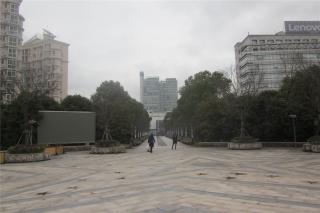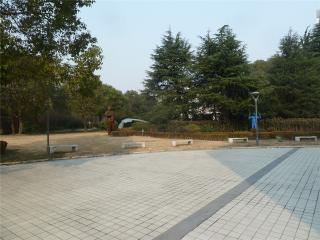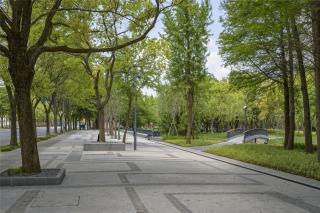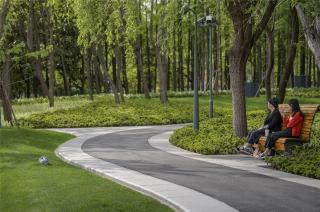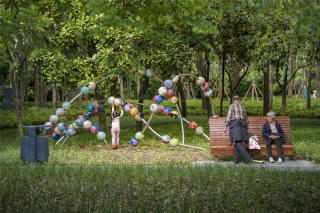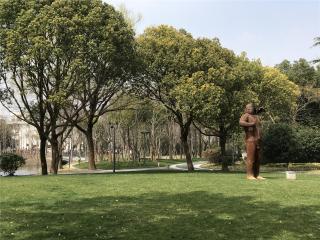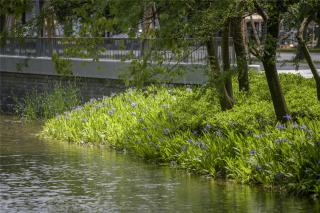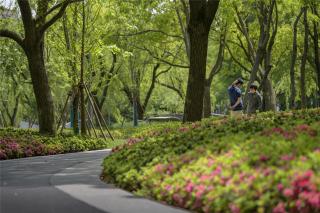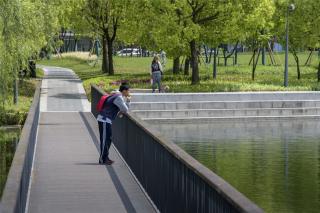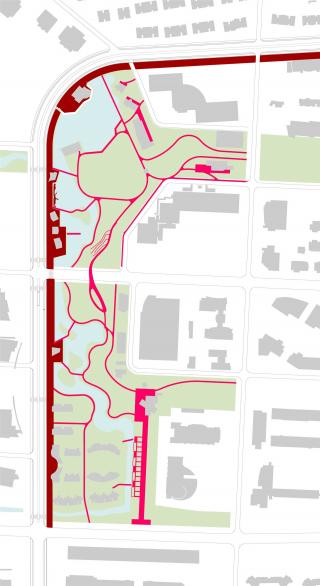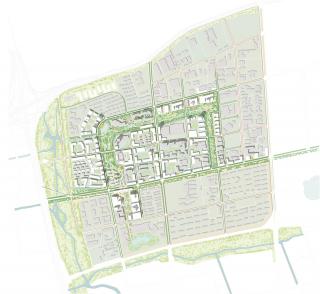張江藝術(shù)公園位于上海浦東張江科學(xué)城西北片區(qū)的核心�,原來(lái)是兩座比鄰的公園�����,被春曉路一南一北分開(kāi),建于不同年代�、風(fēng)格各異。北側(cè)的公園較為開(kāi)敞�����,南側(cè)則林木茂密�。張江當(dāng)代藝術(shù)館位于南側(cè)公園中, 多年以來(lái)積攢了大量?jī)?yōu)秀的室外雕塑作品�,密集放置在南側(cè)公園有限的空間中。
作為West 8參與的張江科學(xué)城西北片區(qū)城市更新項(xiàng)目的一部分�,張江藝術(shù)公園的整合提升將成為西北片區(qū)更新的第一步�。在規(guī)劃上作為西北片區(qū)核心帶狀公共空間--“綠框”公園--的西部起點(diǎn)���,張江藝術(shù)公園將推動(dòng)整個(gè)西北片區(qū)各街區(qū)的多樣化進(jìn)程�,帶動(dòng)社區(qū)商業(yè)和文化的發(fā)展�。
Zhangjiang Art Park is located in the core of the northwest area of Zhangjiang Science City in Pudong, Shanghai. Originally two, adjacent parks divided by the Chunxiao Road in the middle, the north and south parks which were built in different eras and with different landscape styles. The park on the north side was designed with an open character, while park on the south side was densely forested. In addition, the Zhangjiang Contemporary Art Museum is located in the southern park. Over the years, this southern park accumulated a large number of free-standing outdoor sculpture works, which were densely placed in the limited space around the museum.
As part of the West 8’s Northwest District Urban Upgrade Project of the Zhangjiang Science City, the integration and upgrading of Zhangjiang Art Park will be the first step in the renewal of the northwest area. In terms of urban planning, as the western starting point of the central located strip-shaped public space in the northwest area - the "Green frame" park - Zhangjiang Art Park will promote the diversification of the entire northwest area and the development of community commerce and culture.
▼西北片區(qū)城市更新總圖
Urban Upgrade Master Plan of Northwest District
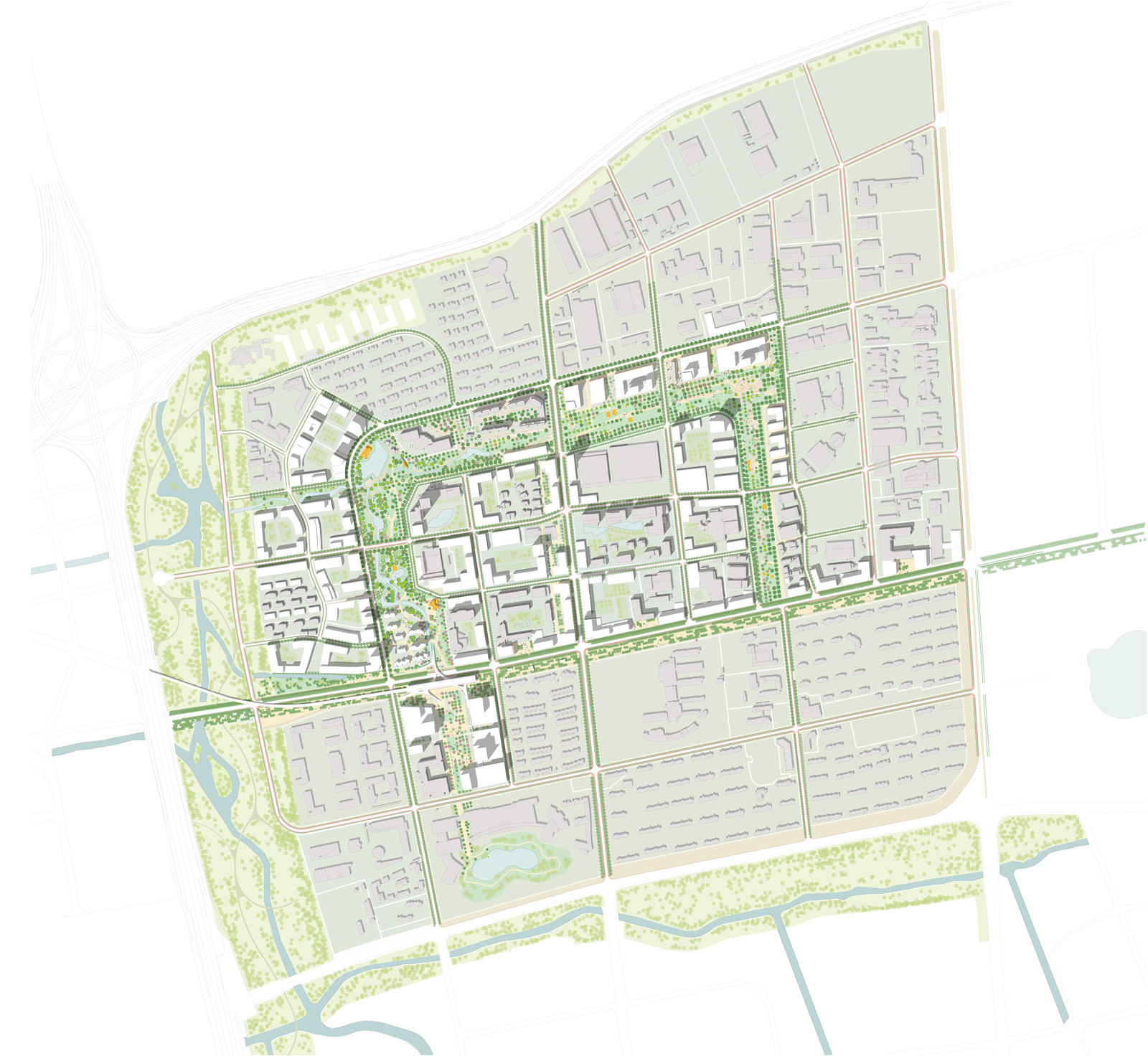
West 8主導(dǎo)了張江藝術(shù)公園的總體規(guī)劃和景觀設(shè)計(jì),同時(shí)與同濟(jì)景觀院等本地顧問(wèn)團(tuán)隊(duì)進(jìn)行了深化合作�����。
景觀改造的基礎(chǔ)是透徹的城市設(shè)計(jì)分析以及定位���。張江藝術(shù)公園改造的第一步�����,即是明確公園和城市界面��,也就是公園與西側(cè)碧波路�、南側(cè)祖沖之路兩條核心干道的關(guān)系�。過(guò)去,公園和碧波路之間有安全圍欄和灌木隔離�,內(nèi)向型的公園既無(wú)法通過(guò)城市道路積攢人氣,也無(wú)法為城市街區(qū)提供怡人的景觀體驗(yàn)。
West 8 led the overall planning and landscape design of Zhangjiang Art Park and cooperated with local consultant teams including the landscape department of the Tongji Architectual Design (Group) Co., Ltd. for the developed design and construction supervision.
The foundation of landscape transformation of the two parks arrived from a comprehensive analysis and positioning from an urban design perspective. The first step was to define the interface between the park and the city, the relationship between the park and the two main roads: Bibo Road on the West and Zuchong Road on the south. In the past, due to the fences and shrubs between the park and Bibo Road, this introverted park could neither accumulate visitors through the urban streets, nor provide a pleasant landscape experience for the surrounded urban blocks.
▼以前的公園邊界
former park edge
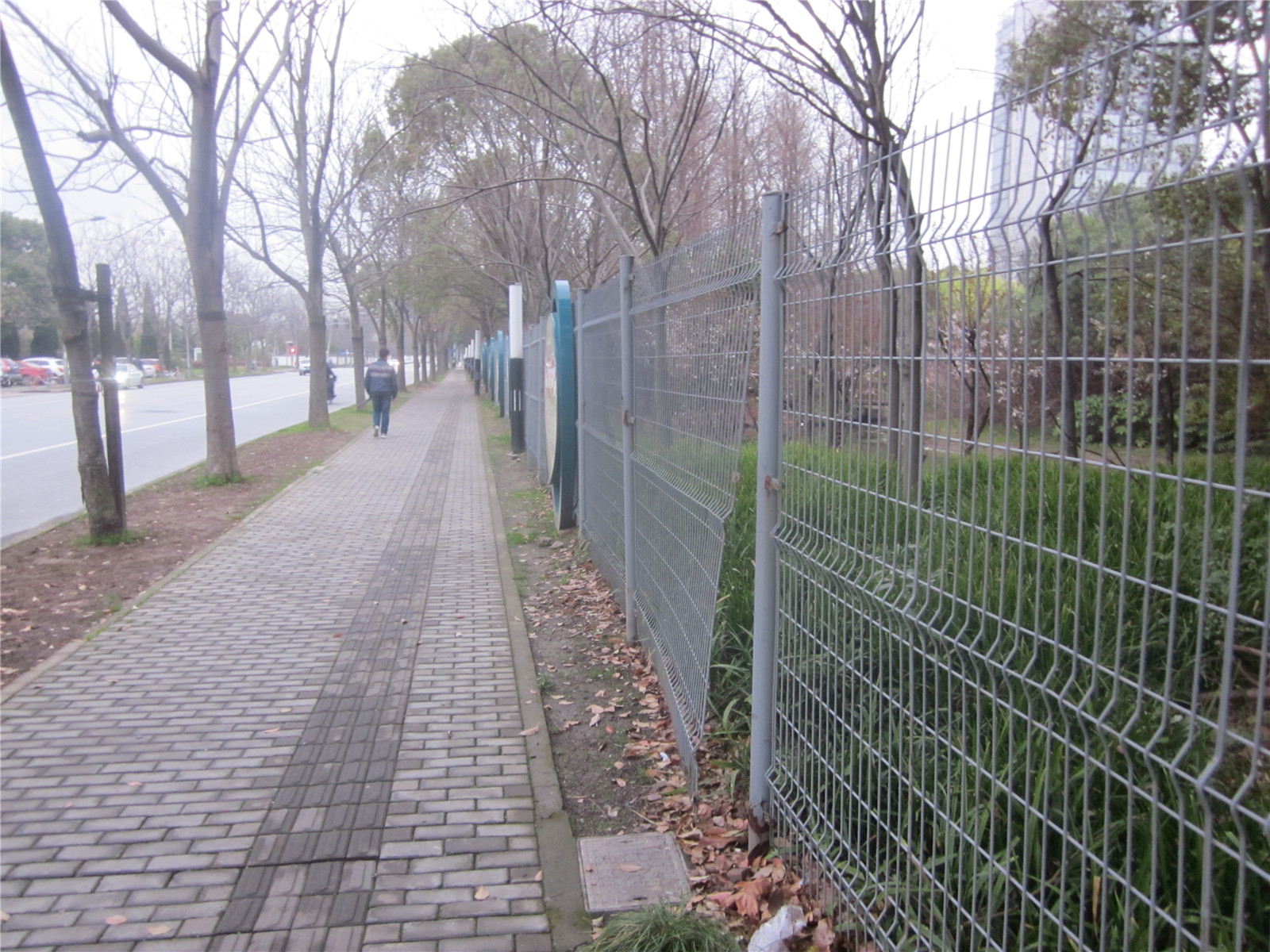
在“綠框”串聯(lián)功能的前提指引下���,一條全新的濱水道沿著公園碧波路一側(cè)縱向推進(jìn)。寬闊的濱水道上�,三色嵌套重疊的鋪裝圖案,強(qiáng)調(diào)了這里作為城市生活魅力核心展示空間的重要性�����。 同時(shí)���,它也是內(nèi)側(cè)柔性公園的景觀背脊線�,清澈的湖面和茂盛的花木沿著這條主要?jiǎng)泳€的東側(cè)徐徐展開(kāi)����,發(fā)散出去的園路和跨越水面的景觀橋使行走在林蔭道上的城市人群擁有了隨時(shí)可以進(jìn)入或離開(kāi)公園的靈活選擇自由度。濱水道如同一條拉鏈����,將以往割裂的公園和城市街區(qū)縫合在一起。景觀與城市發(fā)展相互帶動(dòng)���、共生共榮���。
Under the urban reconnecting principle of the green framed park, a brand new waterfront boulevard is extended along the park edge of Bibo Road. On the widened pedestrian walkway, the three-color overlapped paving pattern emphasizes the importance of this location as the core “show- off space” as the charm of urban life. At the same time, it also acts as the landscape ridgeline between the soft and green park on the inner side. The clear lake and lush flowers and trees slowly spread out along the east side of this main traffic axis. The diverging park paths and the pedestrian bridges across the water give the urban crowd on the boulevard the flexibility to enter or leave the park at any time. The waterfront boulevard is like a zipper, stitching the previously separated parks and urban blocks together. This project is proof that integrating Landscape and urban development drive, coexist and prosper each other, together.
▼濱水道和園路系統(tǒng)
waterfront boulevard and path system
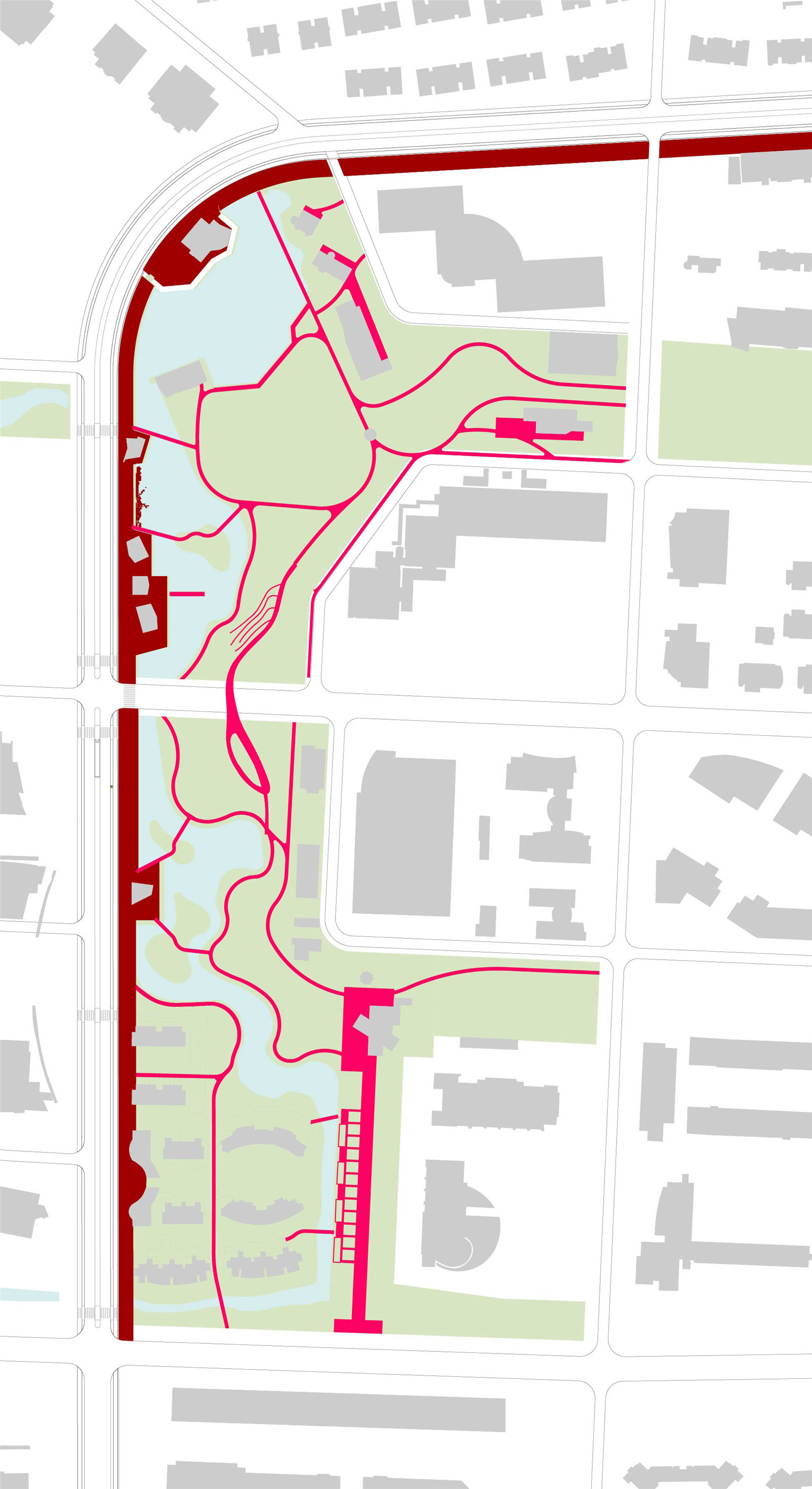
▼濱水道
waterfront boulevard
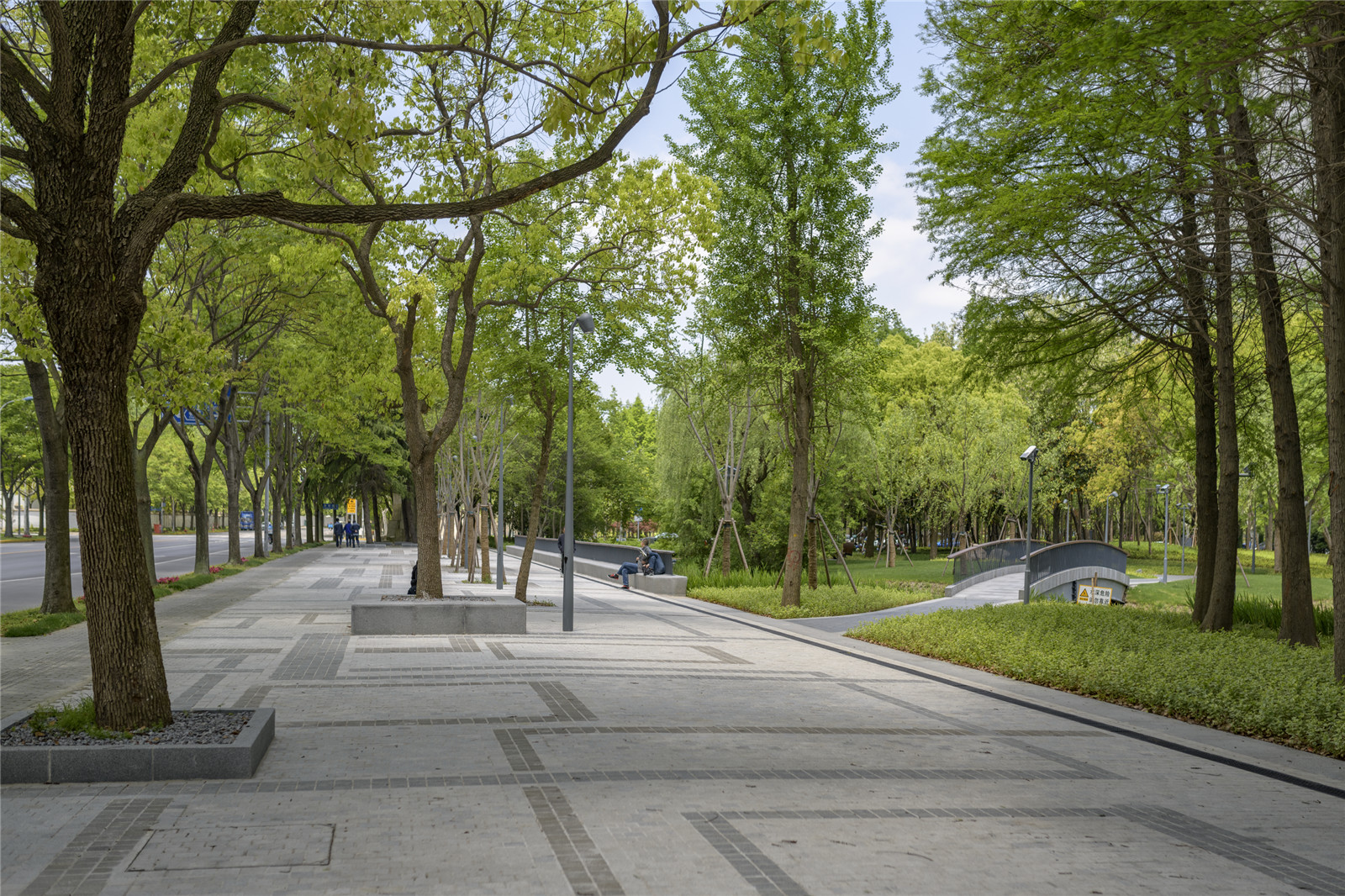
▼濱水道鋪裝圖案
paving pattern of the waterfront boulevard
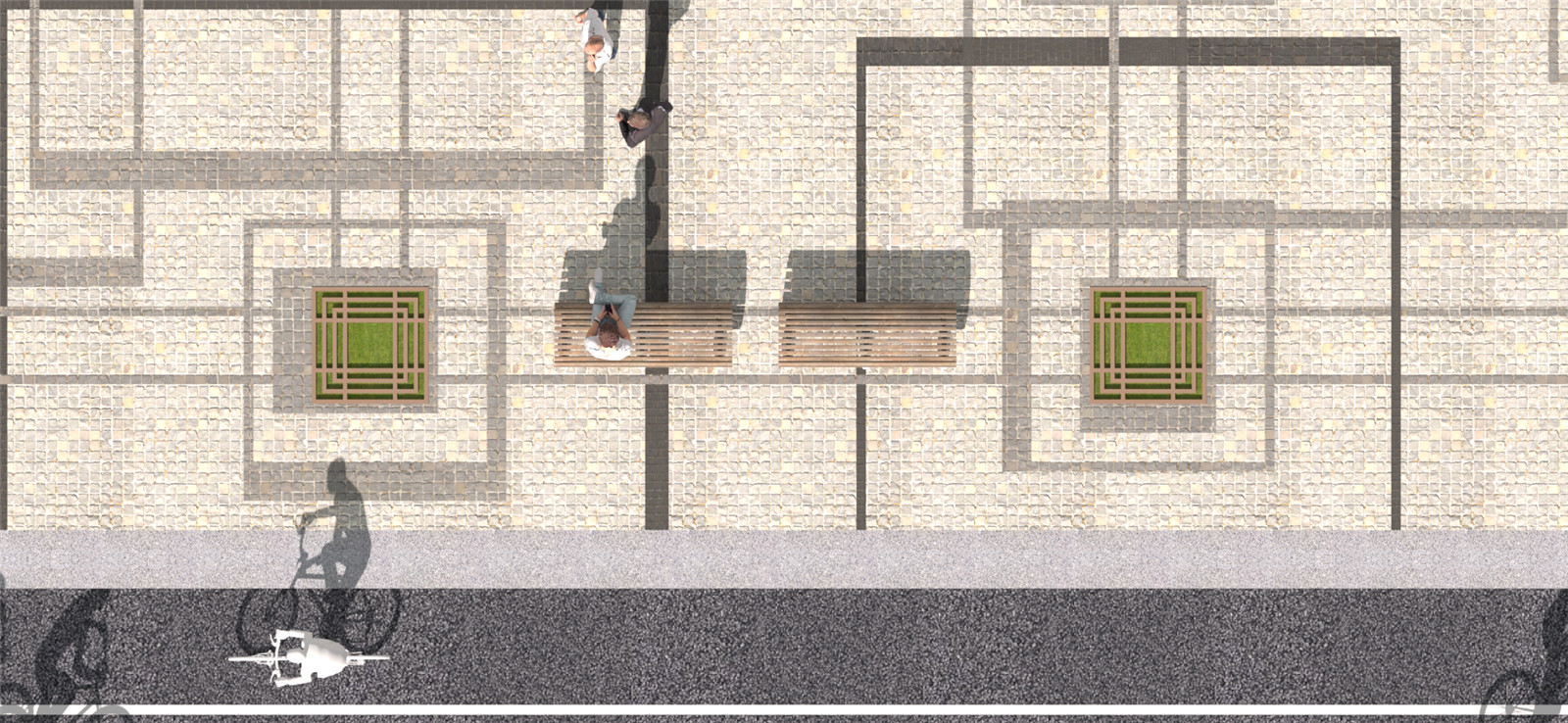
公園南側(cè)����,交通繁忙的祖沖之路和地鐵2號(hào)線張江高科站正對(duì)著張江當(dāng)代藝術(shù)館的中軸線����。一座櫻花樹(shù)冠覆蓋的入口廣場(chǎng)直接面對(duì)車流湍急的祖沖之路,宣示著公園的主入口和通往藝術(shù)館的軸線����。繁茂的樹(shù)冠,過(guò)濾掉祖沖之路上的喧囂氛圍�����,將人們一步步帶入公園的綠色環(huán)境��。中軸線的改造尊重原有的格局�,保留了經(jīng)年生長(zhǎng)成型的大喬木,同時(shí)理清林下空間�、統(tǒng)一設(shè)計(jì)語(yǔ)匯,將這一區(qū)域多年來(lái)逐漸散亂的空間整理為清晰的“軸線-林下步道-水岸”三層并列動(dòng)線����。
On the south side of the park, the Zuchongzi Road with its heavy traffic and Zhangjiang High-tech Metro Station are facing the axis of Zhang Contemporary Art Museum. The entrance plaza, covered by the cherry tree canopy, faces the turbulent traffic to declare the main entrance of the park and strengthen the axis towards the Art Museum. The lush canopy filters out the noise of the Zuchongzi Road and brings people into the green environment of the park step by step. The transformation of the museum axis respects the original layout. The large trees that have grown over the years are kept. At the same time, the space under the trees are cleaned and unified with a coherent design language. The space in this area, which has been gradually scattered over the years, is now reorganized into a clear and linear space, a three-layer axis of "museum - green trail - waterfront walkway".
▼以前的藝術(shù)館軸線
former museum axis
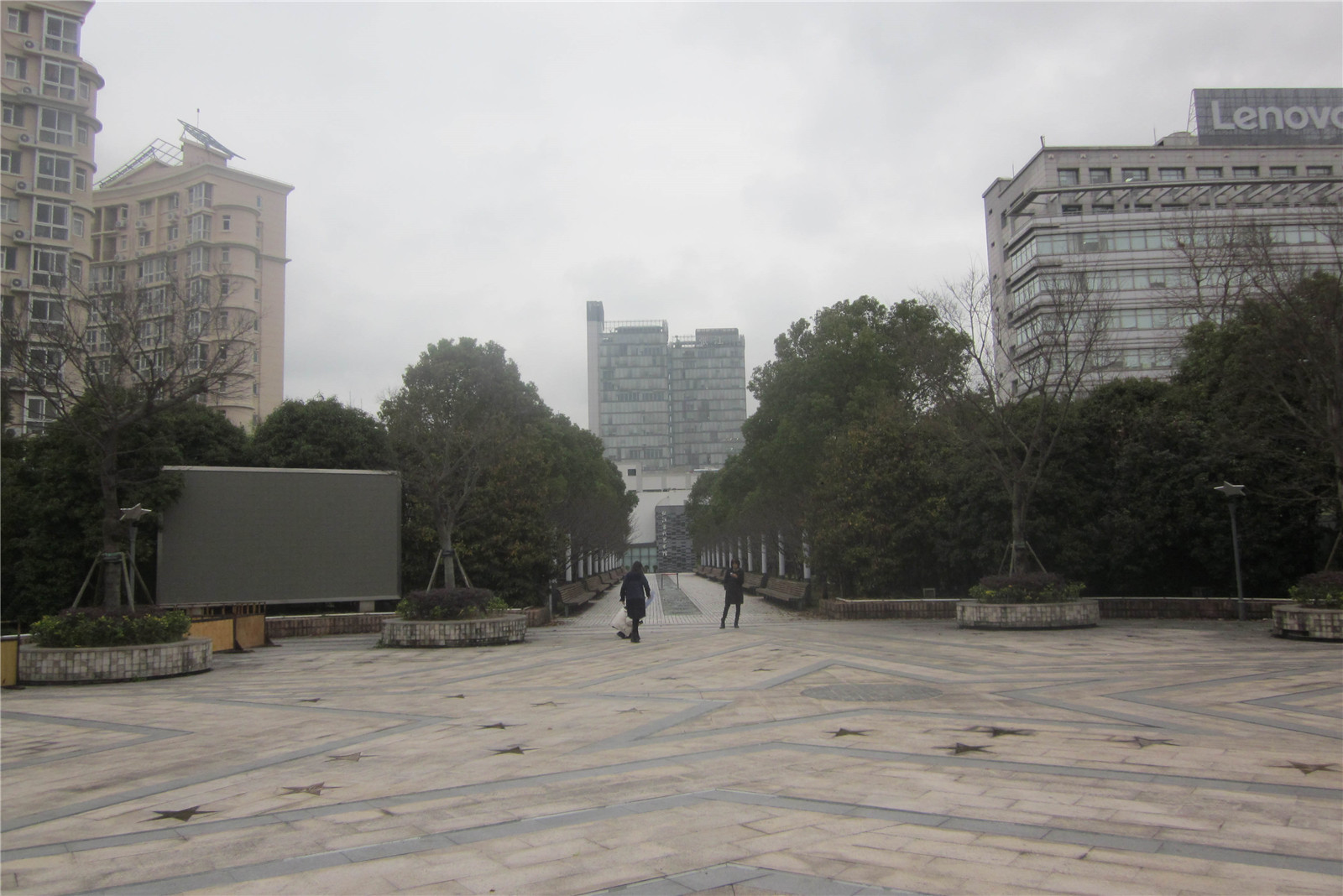
▼樹(shù)蔭下的入口廣場(chǎng)和藝術(shù)館軸線
the entrance plaza under the tree canopy and the museum axis
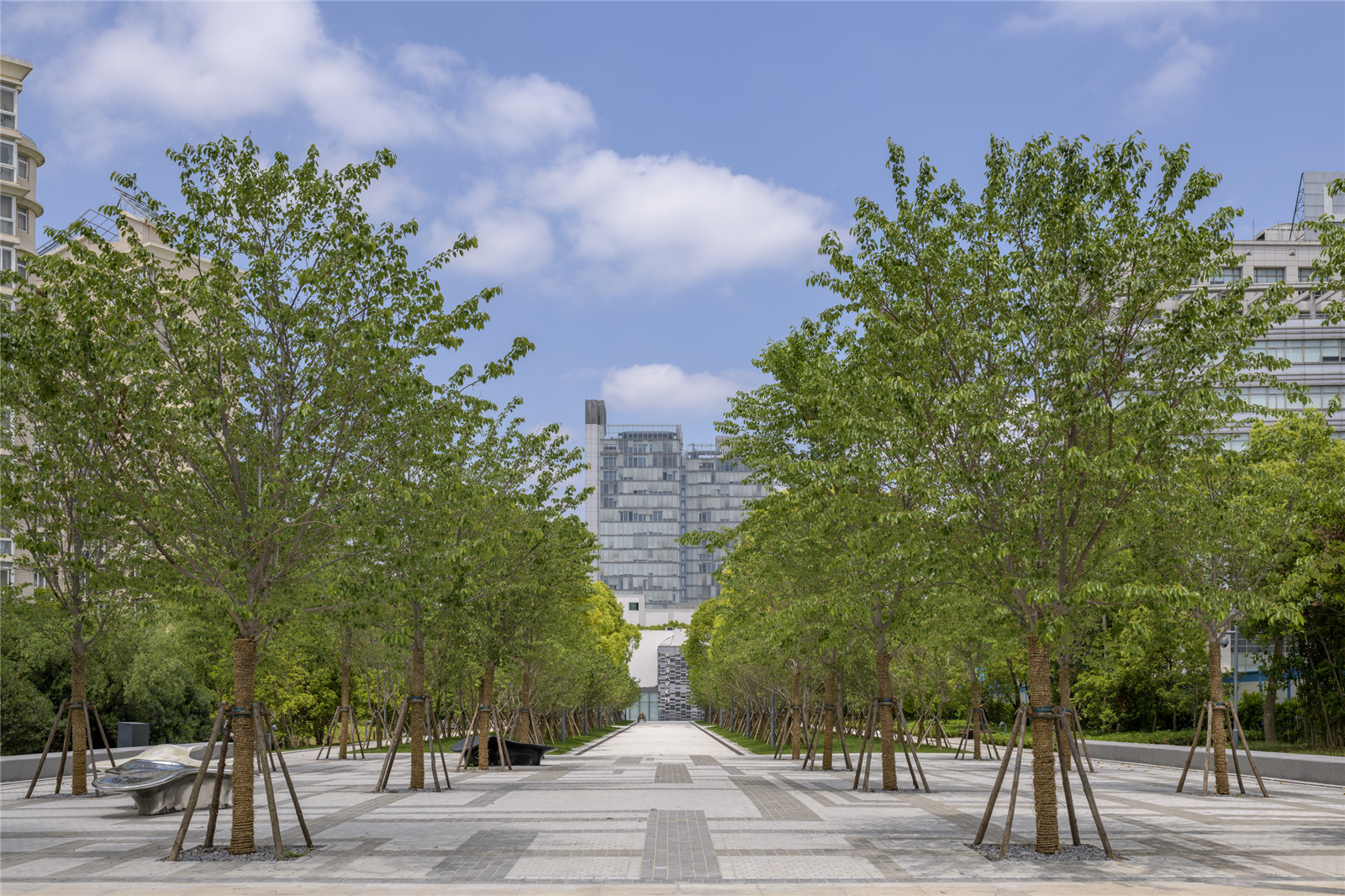
公園的園路在原有路網(wǎng)結(jié)構(gòu)上做了整理和調(diào)整�?��?梢灾貜?fù)利用的現(xiàn)狀路基被盡可能再利用��;對(duì)公園未來(lái)整體流動(dòng)性有阻礙的園路,則果斷拆除���。硬質(zhì)景觀的選材均使用舒適低調(diào)的灰色����。主園路的路面材料使用適合市民慢跑的灰色瀝青���,次園路則是傳統(tǒng)穩(wěn)重的青灰色陶土磚拼嵌路面�。
園路兩側(cè)以寬于一般公園園路的30公分花崗巖側(cè)石配合小彈石夾道�。視覺(jué)上精致、穩(wěn)定���,也更易于兩側(cè)的綠化銜接及養(yǎng)護(hù)�����。側(cè)石的截面是一道平緩的下落弧線��,與路面的排水弧度對(duì)接�����,形成園路如同厚墊子一般的“彈性”視覺(jué)效果�。“硬景軟做”--溫和柔軟的親近感���,為鋒利硬朗的硬質(zhì)磚石景觀帶來(lái)預(yù)想不到的觀感體驗(yàn)�����。
The original paths in the park have been reorganized and adjusted. The existing foundation that can be reused is recycled as much as possible; whereas the park paths which hinder the overall accessibility of the future park is decisively removed. The selection of hard landscape materials are a comfortable and low-key gray color: The main pathways uses gray asphalt which is suitable for jogging, the secondary pathways use traditional and stable blue-gray bricks.
30 cm wide granite curbstones, wider than the general park path, and small cobble stones are holding the path in place on both sides. Besides visually delicate and stable, it is easier to transfer to and easier to maintain the soft green on both sides. As the extension of the drainage slope of the path surface, the cross-section of the curbstone is a gentle curve, akin to a pillow, as a cushioned edge to the soft terrain. "The soft hardscape" - the gentle and soft look and feel bring an unexpected closeness to the sharp and hard granite and brick landscape.
▼硬景”軟”做
the “soft” hardscape
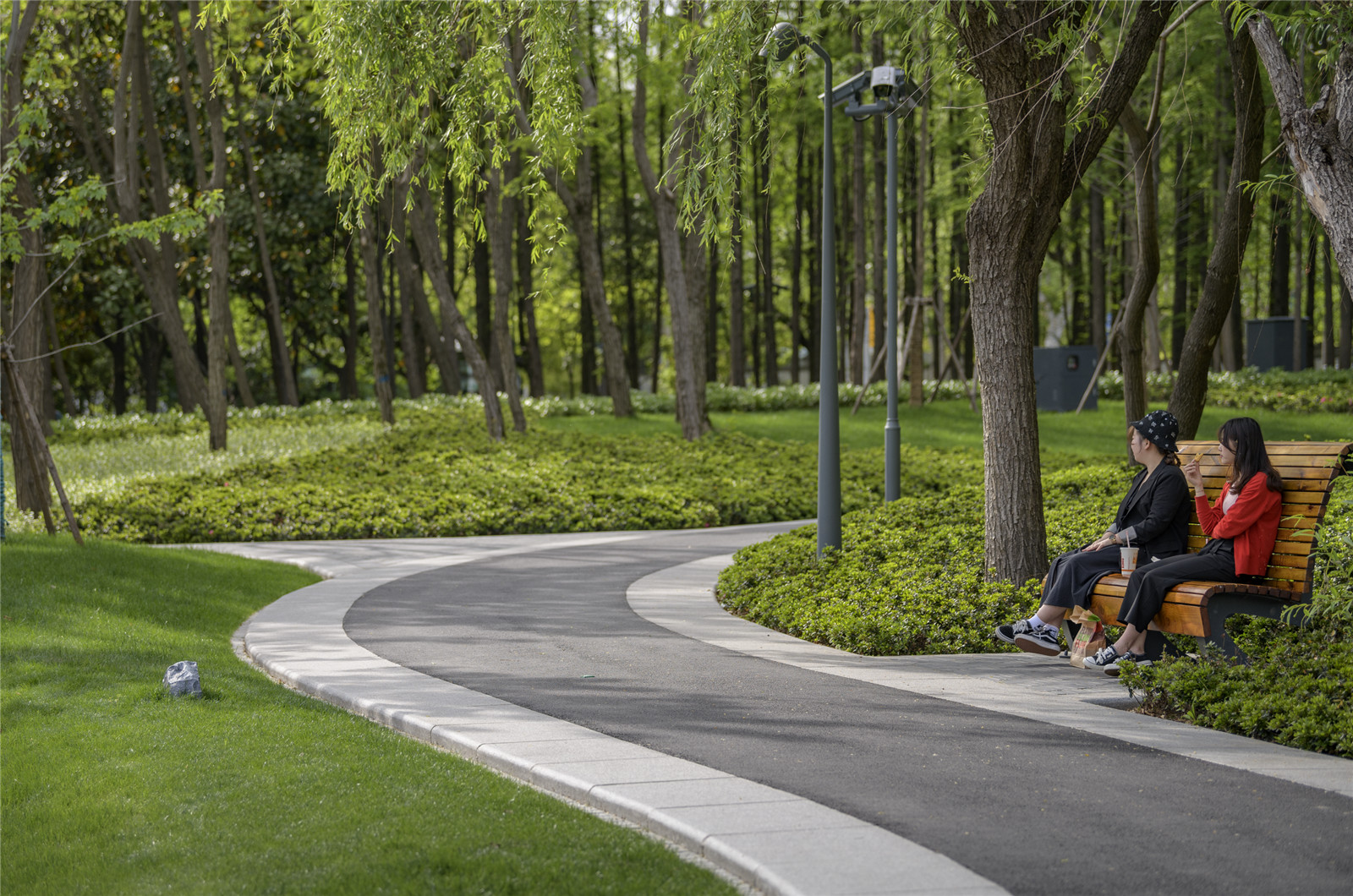
曾經(jīng)密集放置在南側(cè)公園內(nèi)的雕塑藝術(shù)品是這座公園隱藏的財(cái)富����。但是僅南側(cè)公園的規(guī)模已無(wú)法提供足夠空間來(lái)充分展示這些藝術(shù)品的價(jià)值��。在這次改造中���,雕塑品沿南北兩部分公園的園路�,根據(jù)主題被重新編排布置��。在全新設(shè)計(jì)的地形�、水景和植被群落襯托下���,這些藝術(shù)品擁有了各自獨(dú)立的舞臺(tái),成為公園最有代表性的景觀和視線的焦點(diǎn)����。
The artworks, previously densely placed in the park on the south side, are now the hidden treasures of the combined park. During this renovation, the artworks were rearranged, repositioned and relocated in both north and south parks of the park. Against the backdrop of the newly designed terrain, water features and vegetation communities, these artworks with their own independent stages turn to be the most representative focus points in the park an provide a unified theming to the combined parks.
▼在以前的公園中,藝術(shù)品密集放置
artworks densely located in the former park
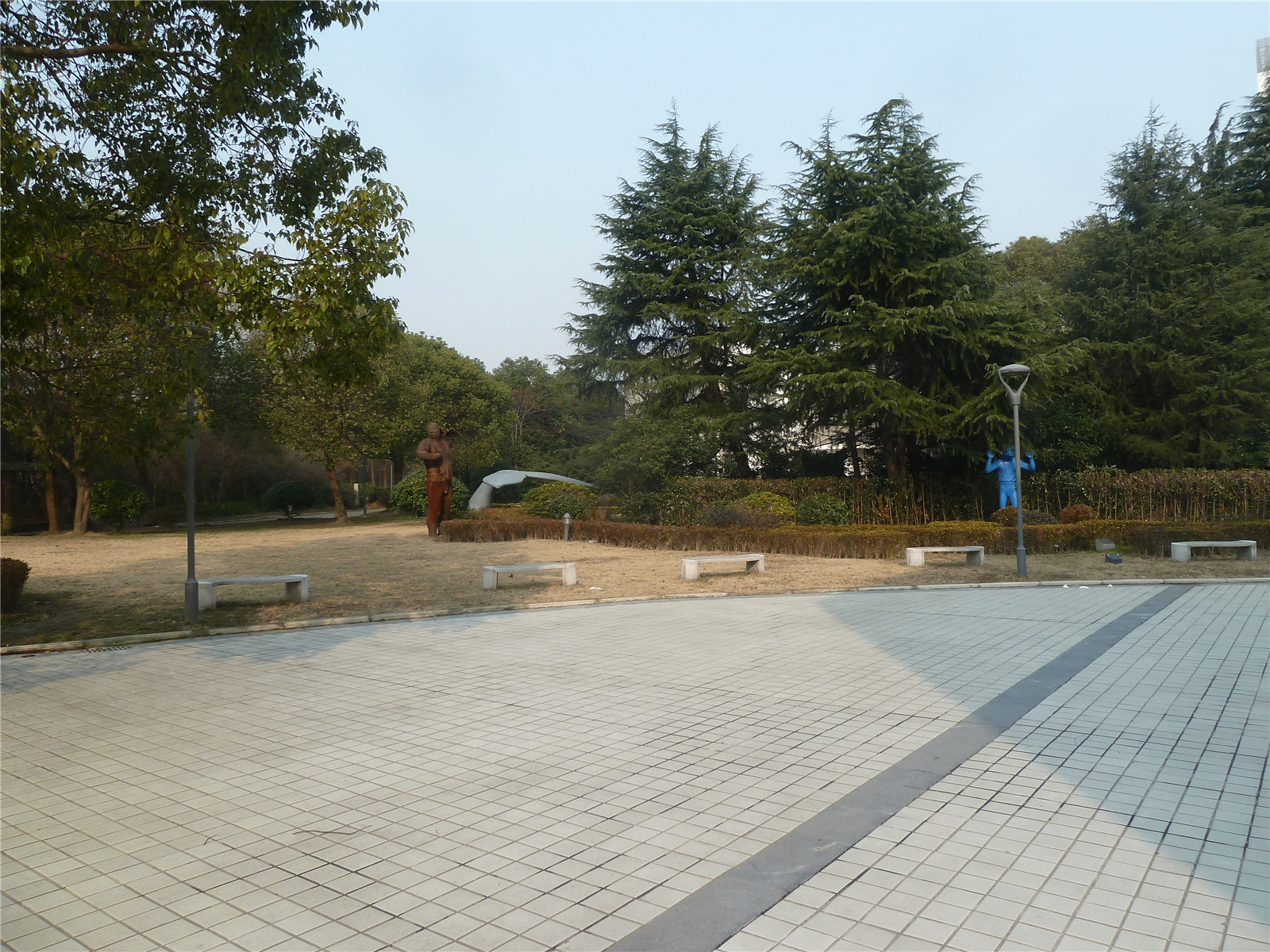
▼藝術(shù)品成為公園最有代表性的景觀和視線的焦點(diǎn)
artworks turned to be the focus points in the park
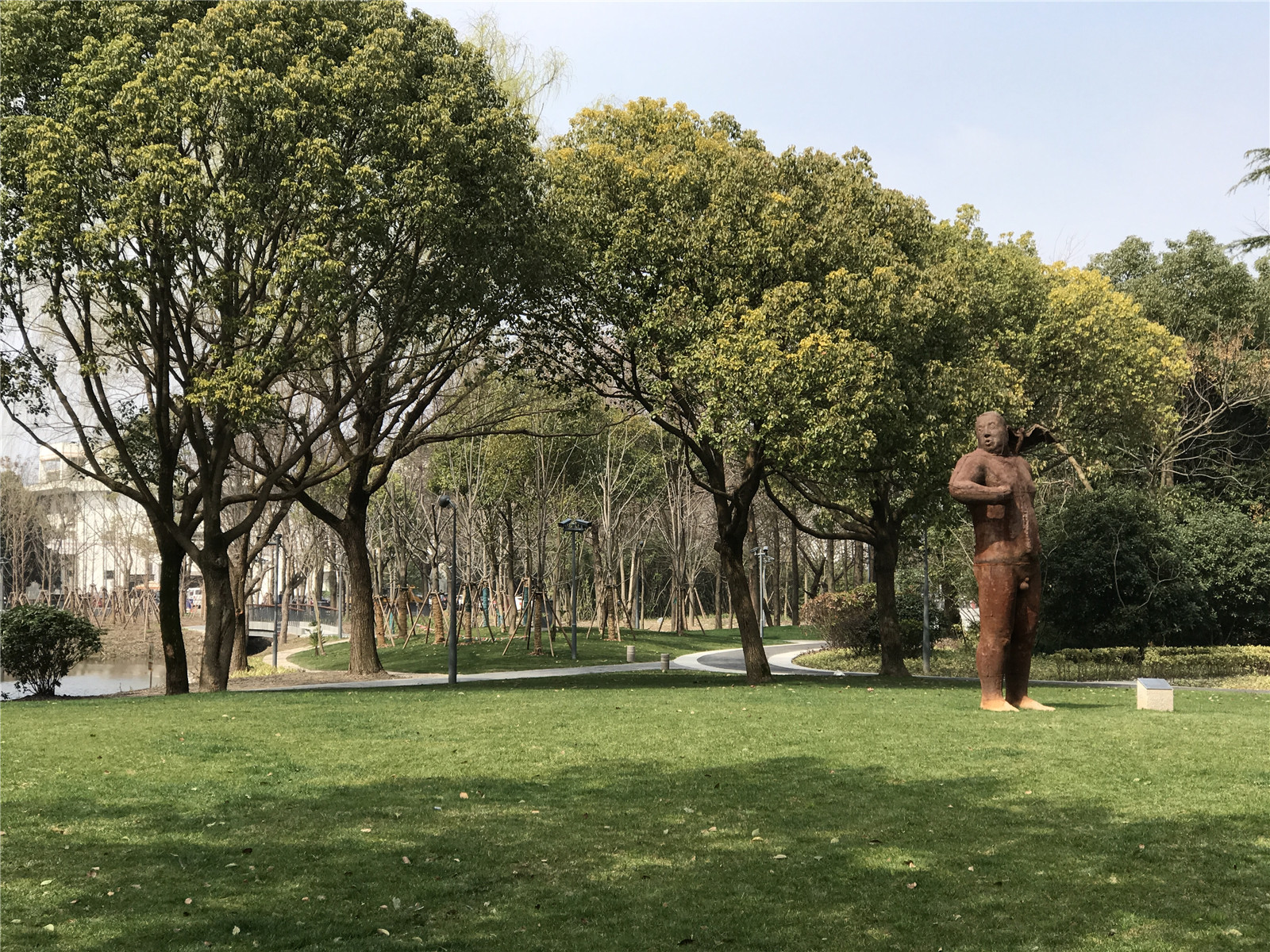
▼藝術(shù)品擁有了各自獨(dú)立的舞臺(tái)
artworks obtained own stages
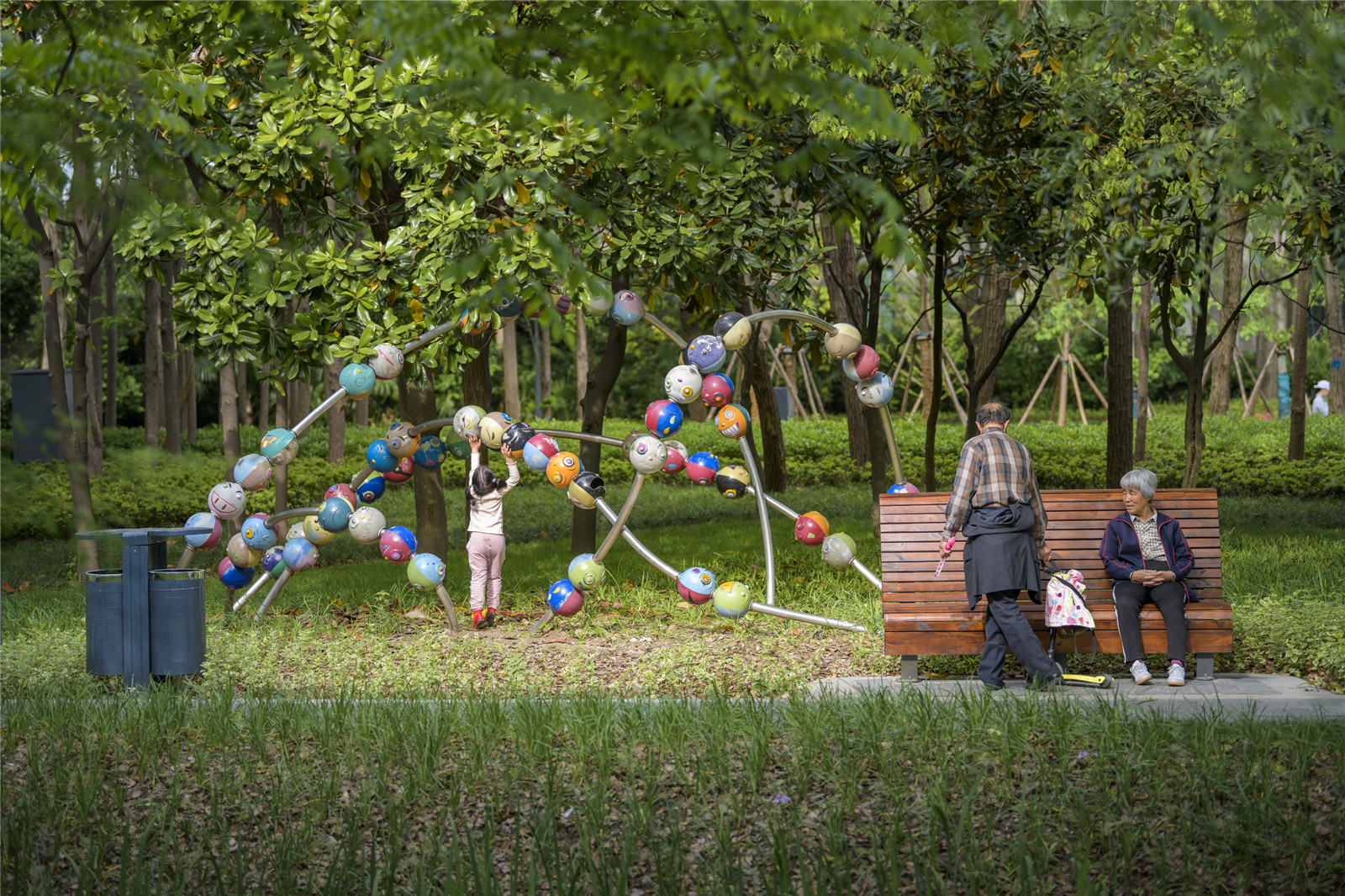
公園原有的湖面和水道���,既是游覽空間劃分的主要元素,也是藝術(shù)品展示的重要舞臺(tái)�。公園的改造需要從水體改造開(kāi)始。因淤積而斷開(kāi)的幾片水系被重新打通��。淤泥經(jīng)過(guò)清理后���,水底種上了可以改善水質(zhì)的生態(tài)水生植物���。原本渾濁的水體再次成為市民親水戲水的好去處。水邊坡岸上����,種植有大片自然蔥郁的水生花卉和植物,雕塑品伏于水畔��,自然與藝術(shù)隨季節(jié)變化而精彩紛呈。
The original lake and waterways in the park are not only the main elements dividing the park spaces, but also an important stage for the display of the artworks. The transformation of the park needs to start with the transformation of the water body. Water bodys that had been disconnected due to siltation were relinked. After the silt is cleaned up, ecological water plants that can improve water quality are planted on the bottom of the water. The former muddy water body once again became a leisure place for citizens to congregate. Large surfaces of lush flowers are planted on the sloping banks. Today, you will see sculptures are lying on the waterside, as nature and art are both expertly highlighted with the changing of the seasons.
▼清潔的湖水吸引市民親水戲水
the clean lake became a leisure place for the citizens
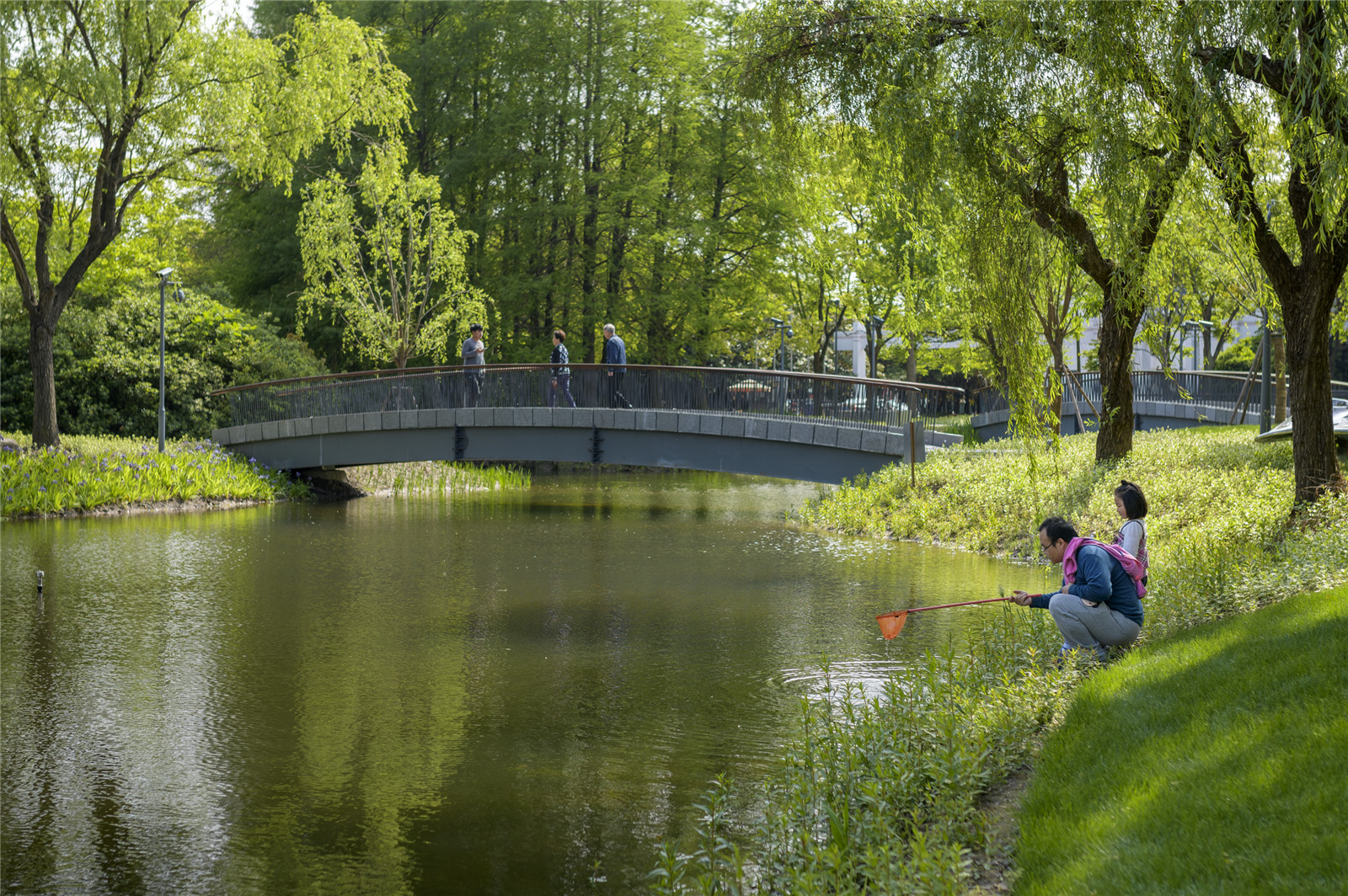
▼水邊坡岸上蔥郁的水生花卉
flowers on the water edge

這次改造的另一個(gè)決定性措施��, 是清理公園中叢生的園林類雜灌木��。經(jīng)過(guò)多年生長(zhǎng)�����,園中的林灌木茂密����。但由于缺乏統(tǒng)一的養(yǎng)護(hù)標(biāo)準(zhǔn),公園中的中下層植被生長(zhǎng)過(guò)度����。加上原有古典園林式的多層植物配置方式,使得公園的可達(dá)性����、安全性和公共活動(dòng)屬性受到嚴(yán)重干擾。甚至于常來(lái)此地的人都不曾意識(shí)到這座公園的存在���。
Another important measure for this renovation was the cleaning up of the garden-style bushes in the park. After years of growth, due to the lack of coherent maintenance standards, the middle and lower vegetation in the park had become overgrown and dense. People who often visited the area were not aware of the existence of the park. This overgrown, dense planting was a symptom of the former classical garden-style multi-layer planting strategy. Today, the park’s accessibility, safety and public awareness is greatly improved.
▼以前���,叢生的園林類灌木遮擋視線
in the former park, overgrown garden-style bushes blocks the view
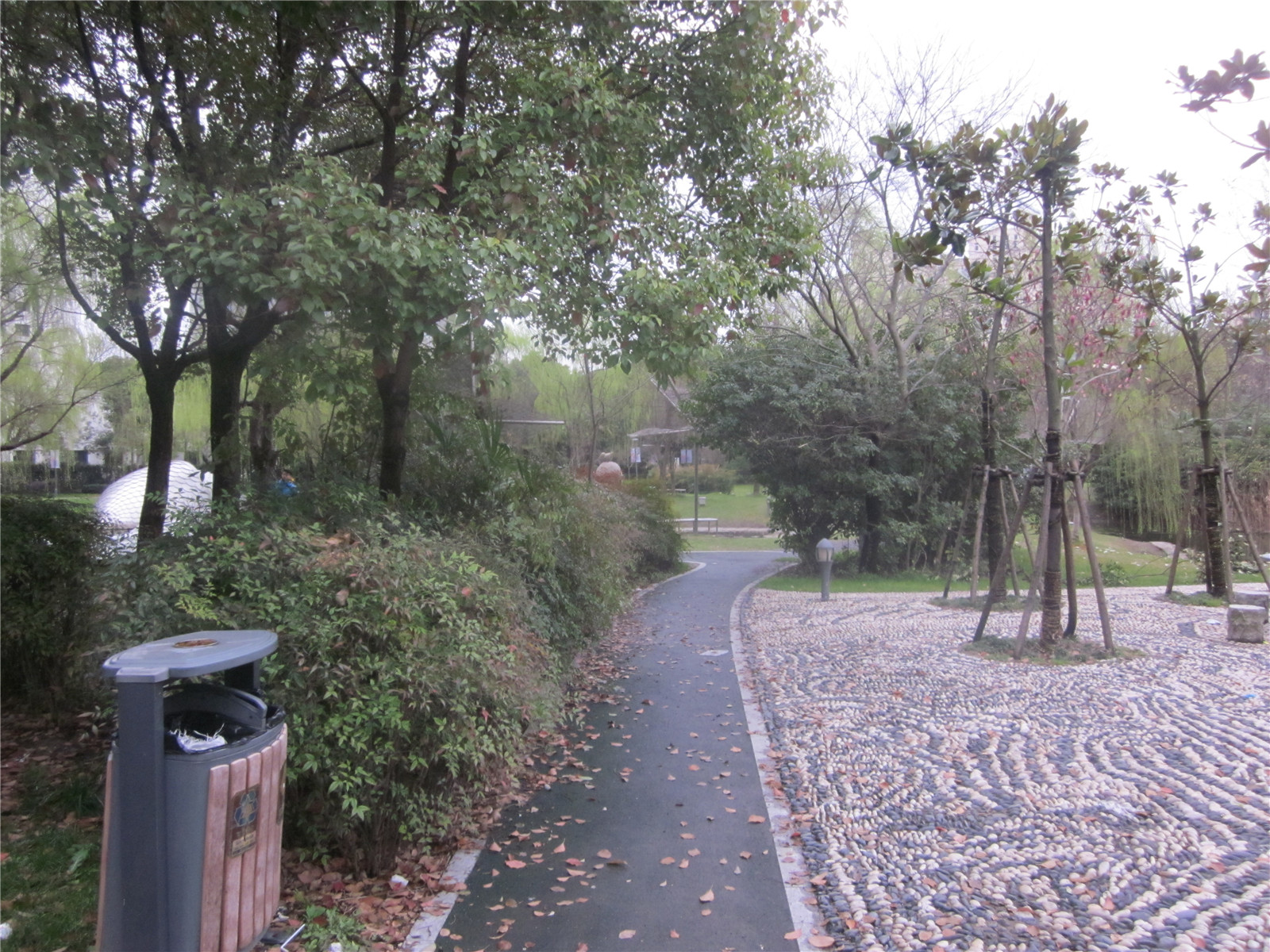
一座位于城市核心區(qū)的市民公園需要與之匹配的植栽策略����。 經(jīng)過(guò)多輪方案比較���,業(yè)主項(xiàng)目管理團(tuán)隊(duì)和設(shè)計(jì)團(tuán)隊(duì)下決心做減法���,將阻隔視線和游客活動(dòng)的0.8-2米區(qū)間中高類灌木去除,打造可以成為城市開(kāi)放空間的“疏林草地”景觀����。打通后的公園視線深遠(yuǎn)、舒朗大氣�����、綠草濃蔭�,通過(guò)開(kāi)敞���、富有層次感的綠色空間�����,城市-公園一體化的人群視線監(jiān)控��,消除了以往公園帶給人的局促和不安全感����。
公園現(xiàn)狀的喬木品種非常豐富。多年生長(zhǎng)后��,移栽的苗木傘蓋已經(jīng)打開(kāi)�,高大舒展,形成了一般新建公園無(wú)法比擬的林冠覆蓋效果�����。在制定改造策略時(shí)�����,除了必要的清理移除外����,大部分生長(zhǎng)良好的喬木都被保留。必須新增喬木的區(qū)域��,有目的性地控制在櫸樹(shù)(濱水道)和落羽杉(公園內(nèi)部綠化)這兩個(gè)品種范圍內(nèi)�����,在保持原有喬木多樣性的同時(shí),避免形成雜亂的視覺(jué)效果����。
A civic park located in the city center needs a matching planting strategy. After rounds of scheme comparisons, the client’s project management team and the design team together determined to remove the medium-high shrubs. Planting in the range of 0.8-2.0-meter-high which blocked the sight and tourist activities were removed to create a type of landscape that can become an public open space in the city: a sparse forest with grass field. Today, the opened-up park has far-reaching sight-lines, a comfortable atmosphere and casts welcoming green shadows. The open layered green spaces and the city-park feeling help to eliminate the previously cramped, unsecured park.
Comparatively, the current tree species in the park are very rich. After years of growth, the canopies of the transplanted trees have opened and fully stretched to form a covering that is incomparable by newly-built parks. While making the transformation strategy, besides the necessary cleaning and removing, most of the well-growing trees have been retained. The area where new trees must be added is purposefully controlled within the range of the two tree species: zelkova is placed on the boulevard and swamp cypress is planted within the park. This maintains the diversity of the original trees, but avoids a messy or cluttered view.
▼保留下來(lái)的高大喬木和全新的主題地被植物帶
preserved mature trees and new themed groundcovers
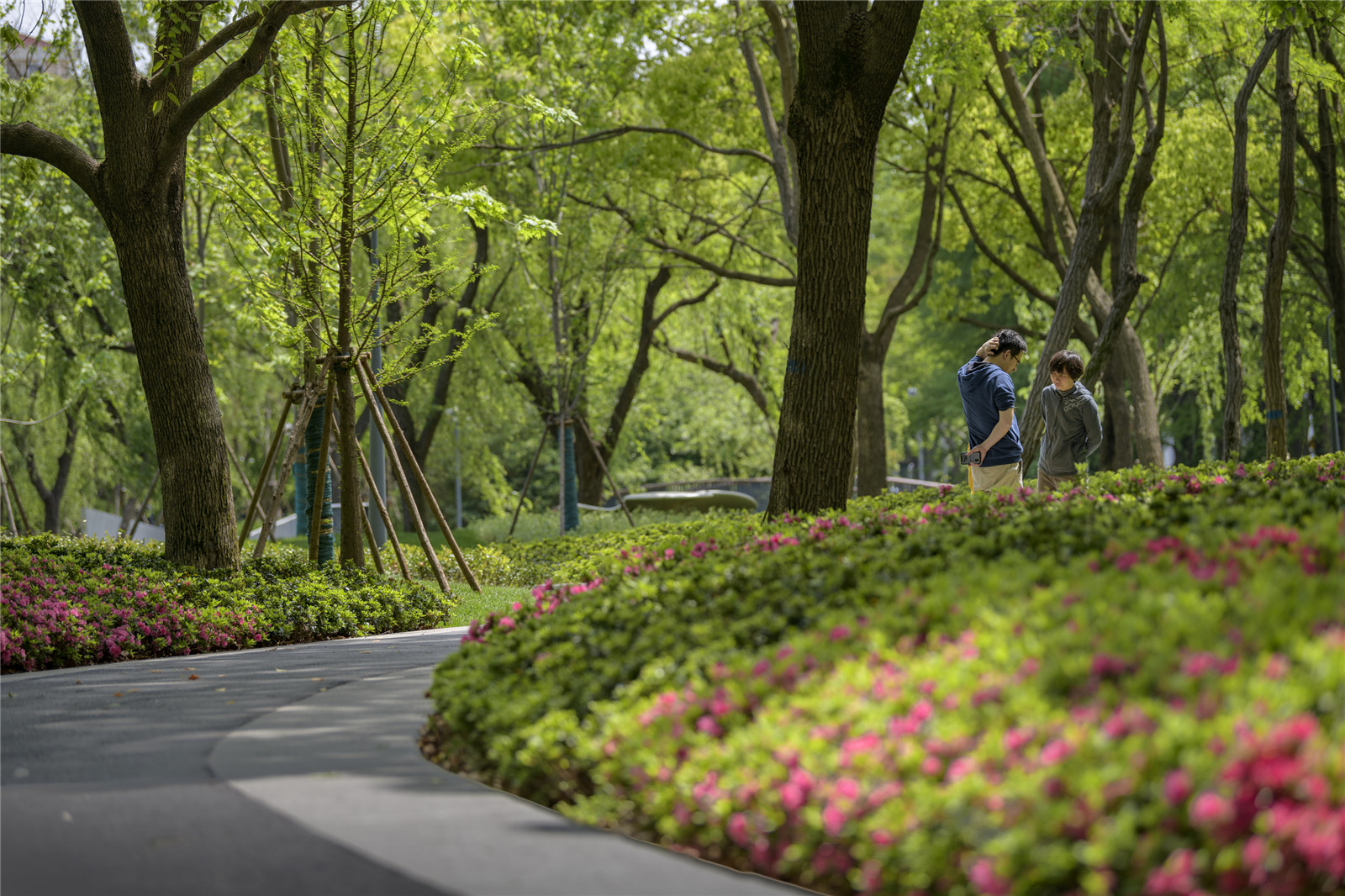
南北區(qū)一大一小各有一塊陽(yáng)光草坪,為市民的休閑活動(dòng)提供了足夠的開(kāi)放空間�。林蔭之下則是蜿蜒伸展、起伏有致的地被植物帶���,高度均在一米以下����。植物帶根據(jù)生長(zhǎng)環(huán)境分為濃蔭���、常綠�、杜鵑谷����、四季花境四個(gè)繽紛主題�,與色彩中性、風(fēng)格統(tǒng)一���、簡(jiǎn)潔低調(diào)的硬質(zhì)景觀形成對(duì)比����。植物的選擇以造型蓬松飽滿、易于養(yǎng)護(hù)為標(biāo)準(zhǔn)���,避免使用質(zhì)感和外形過(guò)于人工化的植物���,或是在某些季節(jié)或生長(zhǎng)階段外形散亂不可控的品種。行走在園路上���,穿行過(guò)一片片四季色彩更迭�、主題交替變化的植物群落���,賞心悅目的同時(shí)也再次強(qiáng)調(diào)出公園以人為本����、以自然為主��、以硬景為輔的設(shè)計(jì)主旨����。
Combined, the North and South parks have a large and one small open, sunny lawn, providing space for recreation of leisure activities for visitors. Under the shade of the trees are winding, undulating ground cover belts, all below one meter of height. In accordance to the growing environment, the ground cover belts are divided into four colorful themes: thick shade, evergreen, rhododendron valley and a four seasons herbaceous border, which provide contrasts with the neutral color, uniform style, simple and low-key hard landscape. The selection of plants is not only full and natural, but also easy to maintain. The design team carefully avoided using plants with artificial textures or appearances, or species with uncontrollable growth stages or appearances in certain seasons. Walking on the park paths, passing through the patches of plant communities with seasonal colors and different themes, it is a treat for the eyes and also emphasizes the people-oriented design goal of the park: nature as a priority, hardscape as background.
▼市民盡情享受陽(yáng)光和清新的空氣
Citizens enjoy the sun and fresh air
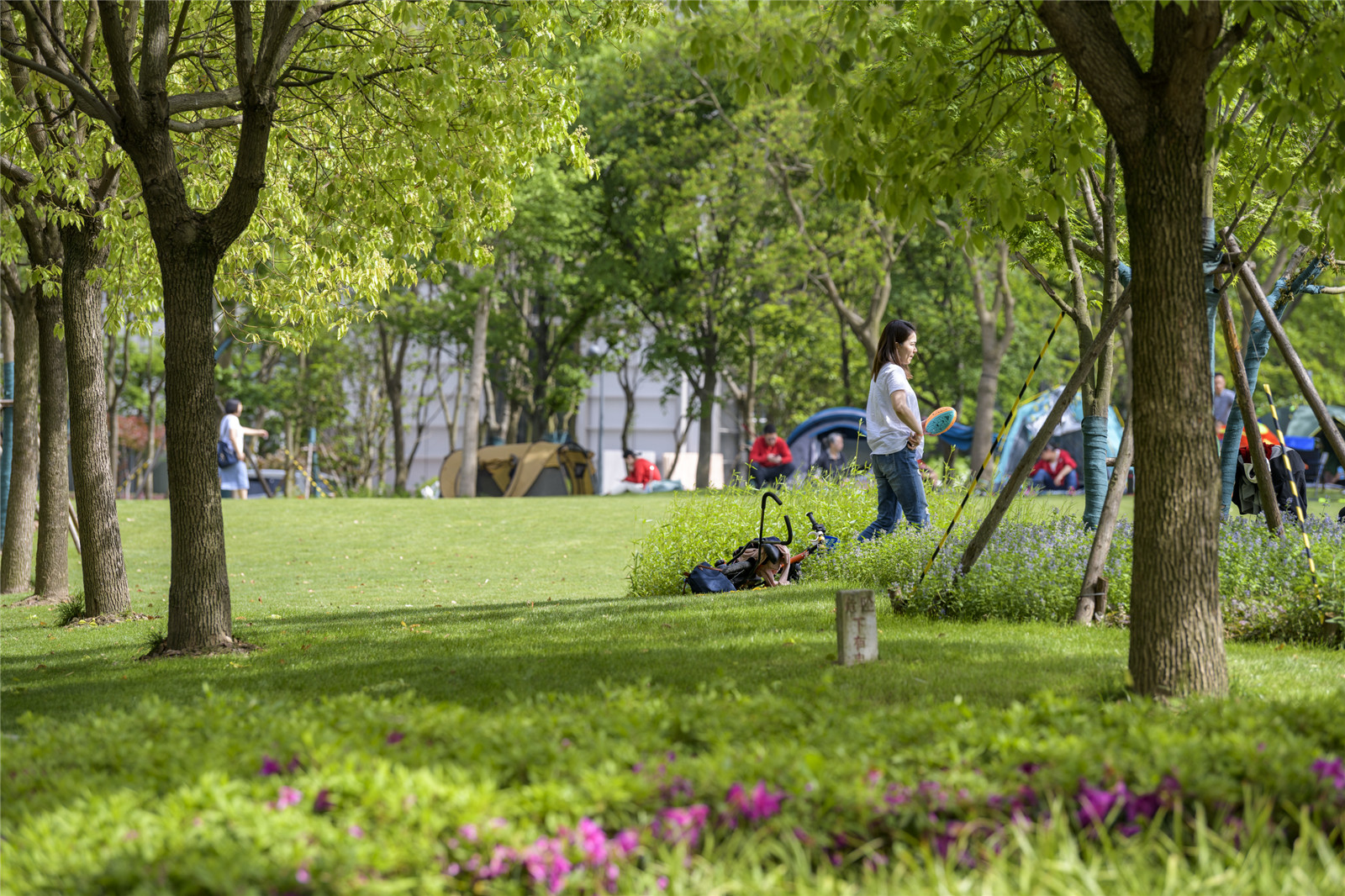
West 8認(rèn)為:改造類項(xiàng)目需要挑戰(zhàn)更多的實(shí)際落地問(wèn)題。特別是在項(xiàng)目后期,會(huì)面臨各類現(xiàn)場(chǎng)突發(fā)情況�����,要求業(yè)主方和設(shè)計(jì)方不斷根據(jù)調(diào)整中的時(shí)間表���、造價(jià)�、規(guī)范���、地下開(kāi)挖情況做出相應(yīng)的妥協(xié)��。
一個(gè)項(xiàng)目很容易因?yàn)楦黝惉嵥槎芗耐獠繅毫?,偏離原有的整體策略��,導(dǎo)致空間的碎片化和設(shè)計(jì)語(yǔ)匯的紊亂�����。在這個(gè)項(xiàng)目中���,業(yè)主方與設(shè)計(jì)方的密切合作尤為關(guān)鍵���。設(shè)計(jì)方必須從專業(yè)角度為業(yè)主提供客觀可靠的陳述和建議,以協(xié)助業(yè)主保持全局性的視角��,做出目光長(zhǎng)遠(yuǎn)的決策�。這個(gè)過(guò)程,既包括城市設(shè)計(jì)角度的整體把性控��,也包括細(xì)節(jié)調(diào)整過(guò)程中的統(tǒng)一性堅(jiān)持����。
West 8 believes that, within a transformation project, there is a need to challenge and propose practical implementation methods and understand the issues regarding a renovation. Especially in the later stages of the project, there will be various on-site emergencies, requiring both owner and the designer to make corresponding compromises according to the adjusted timetable, cost, specifications, and underground excavation conditions.
A project can easily deviate from the original total strategy due to various trivial and intensive external pressures, leading to the fragmentation of space and the disorder of design vocabulary. In this project, the close cooperation between the client and the designers is particularly crucial. The designer must provide the client with objective and reliable explanations and provide suggestions from a professional perspective to help the client maintain a holistic perspective to make long-term decisions. This process includes not only the overall control from the urban design perspective, but also the persistence on unities in the process of detail adjustment.
▼視線深遠(yuǎn),富有層次感的綠色空間
A layered green space with far-reaching vision
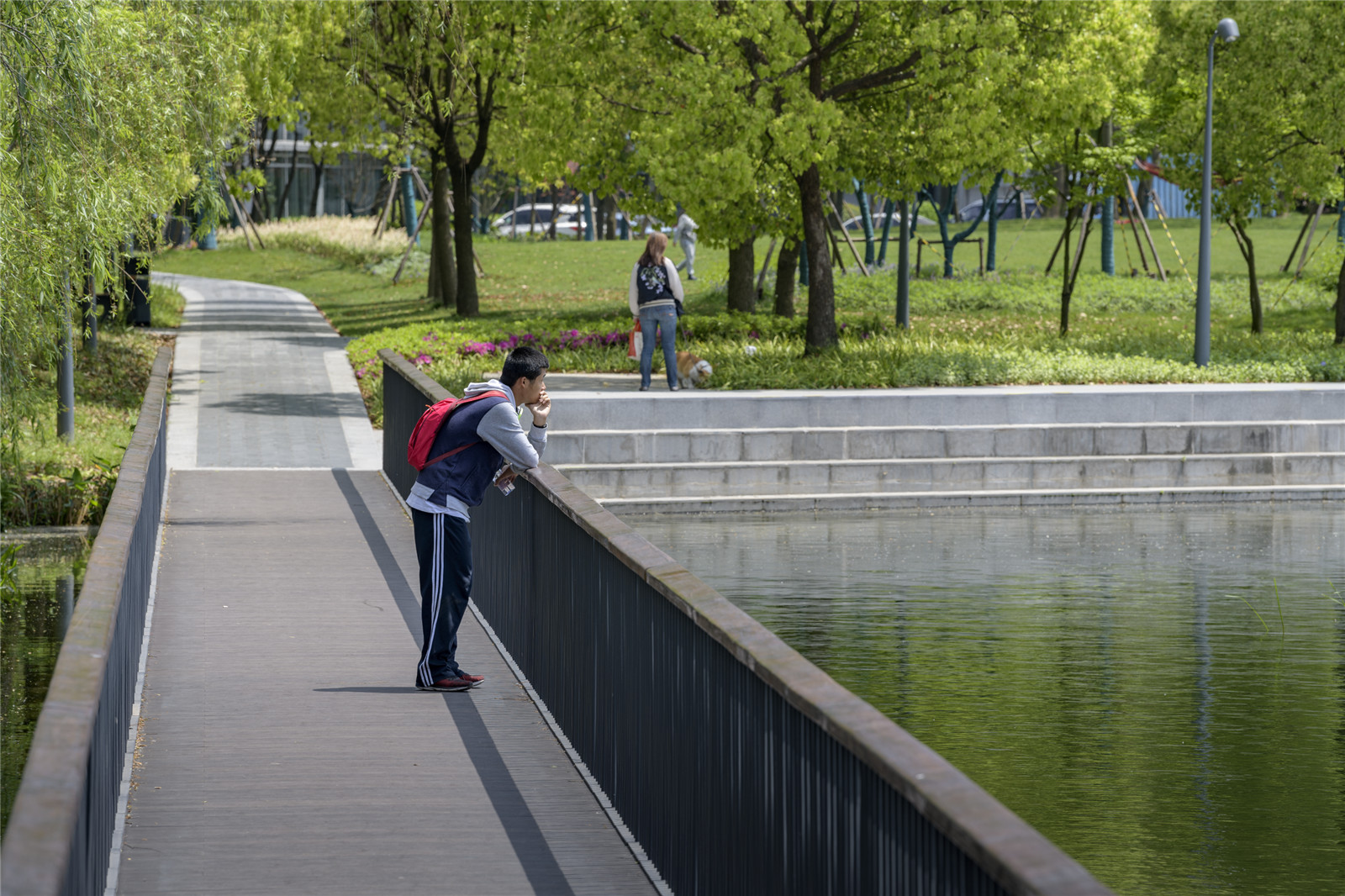
艱苦的工作也帶來(lái)了豐厚的回報(bào)�。張江藝術(shù)公園場(chǎng)地先天的資源優(yōu)勢(shì)--成型的大樹(shù)和卓越的藝術(shù)品,經(jīng)過(guò)設(shè)計(jì)師的梳理�,在開(kāi)放的第一時(shí)間為公園奠定了不可替代的氛圍感。且由于它們已經(jīng)時(shí)間的考驗(yàn)���,必定會(huì)借助于全新的“骨架”���,在未來(lái)很長(zhǎng)一段時(shí)間內(nèi),持續(xù)性地為周邊城市和市民輸出高品質(zhì)的開(kāi)放空間“紅利”�����。
Within this project, hard work brought great rewards. The natural advantages of the site --- large trees with beautiful shapes and excellent artworks laid an irreplaceable atmosphere for the park at the first moment after opening. Because the natural environment already passed the test of time, the new park "framework" provided by West 8 has provided a high-quality open space which will benefit the surrounding city and neighbourhood for a long time in the future.
項(xiàng)目名稱:張江藝術(shù)公園
項(xiàng)目位置:上海浦東張江科學(xué)城
設(shè)計(jì)時(shí)間:2017-2018
建成時(shí)間:2019年
項(xiàng)目面積:8.5公頃
委托方:上海張江高科技園區(qū)開(kāi)發(fā)股份有限公司
合作機(jī)構(gòu):同濟(jì)大學(xué)建筑設(shè)計(jì)研究院(集團(tuán))有限公司
Project: Zhangjiang Northwest Area – Art Park
Location: Shanghai, China
Design: 2017-2018
Realisation: 2019-2019
Size: 8.5ha
Scope of Works: park renovation
Client: Zhangjiang Hi-Tech Park Development Company
Design Team: Christian Dobrick, Yichun He, Laura Font Gallart, Yuxin He, Emanuele Paladin, Fernando Diez, XiaoJun Liu, Francesca Pelizzaro, Ela Chojecka
In association with: Tongji Architectual Design (Group) Co., Ltd.
More information: pr@west8.com
版權(quán)聲明:本文版權(quán)歸原作者所有���,請(qǐng)勿以景觀中國(guó)編輯版本轉(zhuǎn)載���。如有侵犯您的權(quán)益請(qǐng)及時(shí)聯(lián)系�,我們將第一時(shí)間刪除�����。
投稿郵箱:info@landscape.cn
項(xiàng)目咨詢:18510568018(微信同號(hào))
 京公海網(wǎng)安備 110108000058號(hào)
京公海網(wǎng)安備 110108000058號(hào)

















